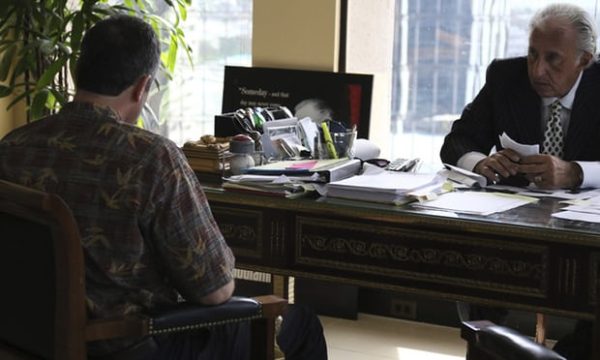

Photograph: Jennifer Sinco Kelleher/AP
Hawaii worker who sent missile alert was ‘100% sure’ attack was real
- Worker fired over false alarm that spread panic speaks out
- Man in his 50s says: ‘It’s been hell for me the last couple weeks’
IA former Hawaii state worker who sent a false missile alert last month said on Friday he was devastated about causing panic but had been “100% sure” at the time that the attack was real.
t took nearly 40 minutes for the agency to figure out a way to retract the false alert on the same platforms it was sent to. People on the islands were sent into panic, many believing they had minutes left to contact loved ones and most without any sense of where to shelter from a possible nuclear strike.
The worker, a man in his 50s, spoke to reporters on the condition that he not be identified because he has received threats. He said an on-duty call that came in on 13 January did not sound like a drill. State officials have said other workers clearly heard the word “exercise” repeated several times.
“Immediately afterward, we find out it was a drill and I was devastated,” the man said. “I still feel very badly about it. I felt sick afterward. It was like a body blow.”
The man said he has had difficulty eating and sleeping, adding: “It’s been hell for me the last couple weeks.”
The Hawaii emergency management agency fired the worker after the incident. His superiors said they knew for years he had problems performing his job. The worker had mistakenly believed drills for tsunami and fire warnings were actual events and colleagues were not comfortable working with him, the state said.
His supervisors counseled him but kept him for a decade in a position that had to be renewed each year, authorities said. The ex-worker disputed that, saying he was not aware of any performance problems.
While starting a Saturday shift at the emergency operations center in a former bunker in Honolulu’s Diamond Head crater on 13 January, the man said, a co-worker took a phone call over the US Pacific Command secure line that sounded like a real warning, he said.
“When the phone call came in, someone picked up the receiver instead of hitting speakerphone so that everyone could hear the message,” he said. The man said he did not hear the beginning of the message that said “exercise, exercise, exercise”.
“I heard the part, ‘this is not a drill”,’ he said. “I didn’t hear exercise at all in the message or from my co-workers.”
Federal and state reports say the agency had a vague checklist for missile alerts, allowing workers to interpret the steps they should follow differently. Managers did not require a second person to sign off on alerts before they were sent and the agency lacked any preparation on how to correct a false warning.
Those details emerged on Tuesday in reports on investigations about how the agency mistakenly blasted cellphones and broadcast stations with the missile warning.
“The protocols were not in place. It was a sense of urgency to put it in place as soon as possible. But those protocols were not developed to the point they should have,” retired Brig Gen Bruce Oliveira, who wrote the report on Hawaii’s internal investigation, said at a news conference.
The Hawaii emergency management agency administrator, Vern Miyagi, resigned as the reports were released. Officials revealed that the employee who sent the alert was fired on 26 January. The state did not name him.
The agency’s executive officer, Toby Clairmont, said on Wednesday he stepped down because it was clear action would be taken against agency leaders after the alert. Another employee was being suspended without pay, officials said.
The incident “shines a light” on the state’s system failures, the man who sent the alert said, adding that he believed the federal government should handle such alerts.
Testing of the alert system began in November and protocols were constantly changing, he said. “As far as our level of training was concerned, I think it was inadequate,” he said.
A Hawaii state department of defense spokesman, Lt Col Charles Anthony, declined to comment on what the former worker said.
Officials said the man refused to cooperate with state or federal investigations beyond providing a written statement. He said he was not trying to impede any investigations: “There really wasn’t anything else to say.”
more recommended stories
 Pelosi Statement on President Biden’s Historic Student Debt Relief
Pelosi Statement on President Biden’s Historic Student Debt ReliefAUGUST 24, 2022 PRESS RELEASE San.
 NY Times Reveals Racist Double-Standard in Mayra Flores Smear
NY Times Reveals Racist Double-Standard in Mayra Flores SmearByJacob Bruns July 7, 2022 NY.
 World Health Organization Issues New Guidelines On Abortion Including Ending All Time Limits Restricting Abortions
World Health Organization Issues New Guidelines On Abortion Including Ending All Time Limits Restricting AbortionsAccess to safe abortion critical for.
 Polk County First Confirmed Case Of Rabies In 2022
Polk County First Confirmed Case Of Rabies In 2022MAR 3, 2022 Media Contact: Brian Bruchey,.
 Judge Blocks Effort To Keep Cawthorn Off NC Ballots
Judge Blocks Effort To Keep Cawthorn Off NC BallotsUpdated March 4, 2022 2:00 p.m..
 Florida Legislature Passes Bill Banning Abortions After 15 Weeks
Florida Legislature Passes Bill Banning Abortions After 15 WeeksPresident Office — Press Release FOR.
